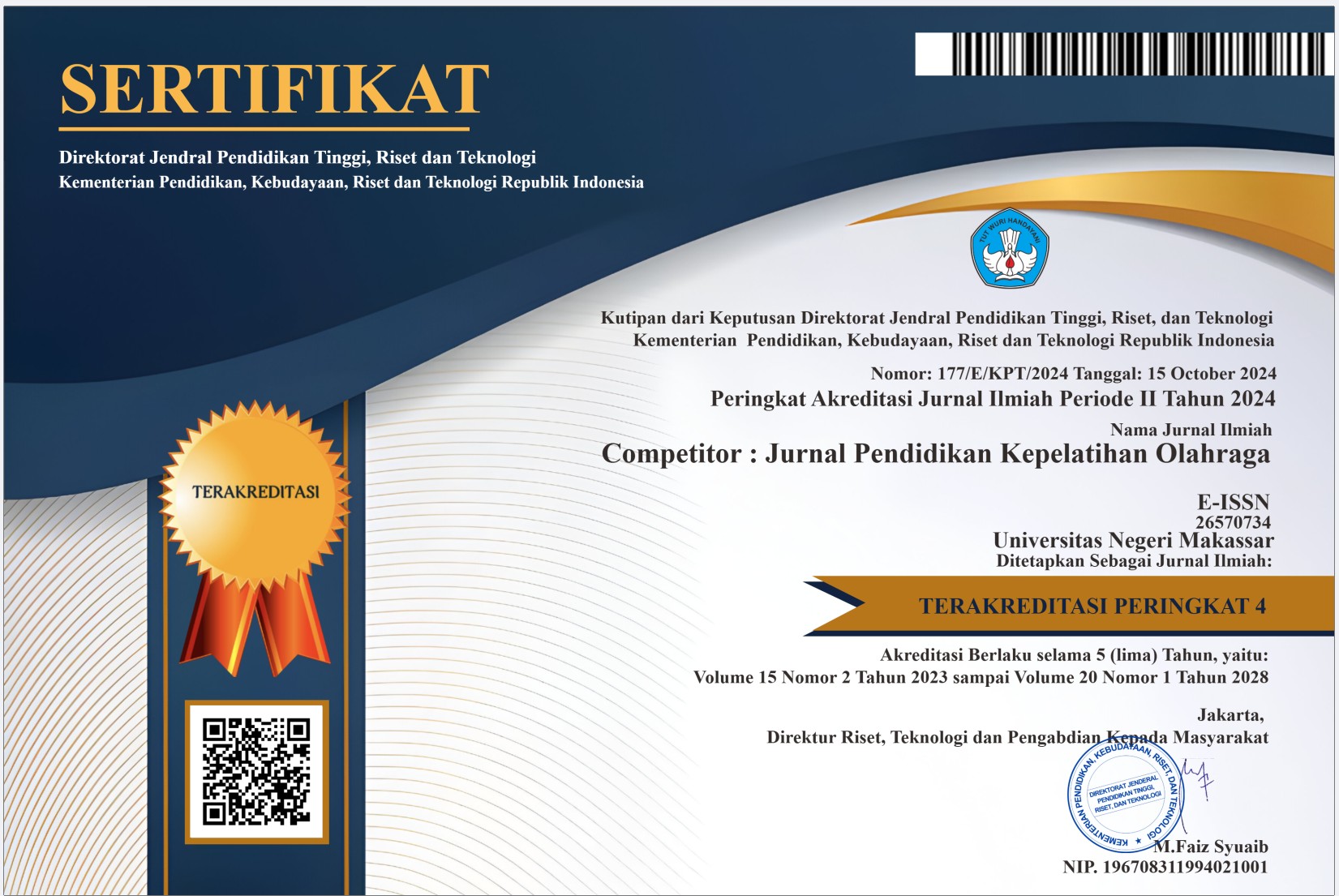The Effect Of Dumbbell Weight Training On The Upper Service Ability Of The Women's Volleyball Club of Pasir Indah Village
DOI:
https://doi.org/10.26858/cjpko.v17i2.107Keywords:
Dumbbell Weight; Training; Upper Service; Women's; Volleyball.Abstract
This study began with the results of observations that had been carried out at the Pasir Indah Village Women's Volleyball Court. It was found that there were still many players who did not have good upper service skills; most players performed upper services with the wrong technique. This study aims to determine the Effect of Dumbbell Weight Training on the Upper Service Ability of the Pasir Indah Village Women's Volleyball Club. This study was conducted using a quasi-experimental method with a One-Group Pretest-Posttest Design. The population in this study were 16 Pasir Indah Village Women's Volleyball Players, while the sampling technique used was saturated sampling, where all populations were sampled. The research design used a Pre-Test and Post-Test. The instrument used was an upper service ability test. Data analysis and testing of research hypotheses used the independent t-test (t-test) analysis technique with a significance level of α = 0.05. The test results showed that there was an Effect of Dumbbell Weight Training on Upper Service Ability. The hypothesis test shows a value (t count 15.025 > t table 1.753), so that it shows that Ho is rejected and Ha is accepted, which means that there is a significant influence on increasing the ability of upper service after being treated with the Dumbbell Weight Training Method.
References
Behm, D. G., Young, J. D., Whitten, J. H. D., Reid, J. C., Quigley, P. J., Low, J., ... & Chaouachi, A. (2015). Effectiveness of traditional strength training vs. power training on muscle strength and power output: A meta-analysis. Journal of Sports Sciences, 33(14), 1438–1446. https://doi.org/10.1080/02640414.2014.988739
Clemente, F. M., Martins, F. M., & Mendes, R. S. (2016). Periodization based on small-sided games: Theoretical considerations. Strength and Conditioning Journal, 38(1), 71–78.
Czaprowski, D., Afeltowicz, A., Giemza, C., Pawłowska, P., & Tomczak, M. (2012). Assessment of postural control and proprioception in volleyball players. Polish Journal of Sport and Tourism, 19(1), 19–23.
Davids, K., Araújo, D., & Vilar, L. (2013). An ecological dynamics approach to skill acquisition. Talent Development & Excellence, 5(1), 21–34.
Gabbett, T. J., Jenkins, D. G., & Abernethy, B. (2011). Physical demands of professional rugby league training and competition using microtechnology. Journal of Science and Medicine in Sport, 15(1), 80–86. https://doi.org/10.1016/j.jsams.2011.07.004
Hewett, T. E., Ford, K. R., & Myer, G. D. (2016). Anterior cruciate ligament injuries in female athletes: Part 2, a meta-analysis of neuromuscular interventions. American Journal of Sports Medicine, 34(3), 490–498.
Lees, A., & Nolan, L. (2012). The biomechanics of the volleyball serve. Journal of Sports Sciences, 20(10), 813–827.
Lima, R. F., Ugrinowitsch, C., & Tricoli, V. (2019). Biomechanical analysis of volleyball serve: Effects of strength training on performance. Journal of Physical Education and Sport, 19(1), 233–239.
Nimphius, S., McGuigan, M. R., & Newton, R. U. (2015). Relationships between strength, power, speed, and change of direction performance of female softball players. Journal of Strength and Conditioning Research, 24(4), 885–895.
Oyen, M., & Smits, D. (2014). Coordination development in volleyball athletes. Journal of Sports Movement, 3(2), 87–95.
Palao, J. M., & Valadés, D. (2014). Match analysis of serve effectiveness in volleyball: A review. Journal of Human Kinetics, 41, 53–63. https://doi.org/10.2478/hukin-2014-0034
Peña, J., Moreno-Doutres, D., Coma, J., & Buscà, B. (2013). Relationship between vertical jump and serve velocity in professional volleyball. Revista de Psicología del Deporte, 22(1), 11–17.
Raab, M. (2014). Simple heuristics in sports. International Review of Sport and Exercise Psychology, 7(1), 104–120.
Rodríguez-Ruiz, D., Quiroga, M. E., Miralles, J. A., Sarmiento, S., de Saá, Y., & García-Manso, J. M. (2011). Study of the technical and tactical variables determining set win or loss in top-level European men's volleyball. Journal of Quantitative Analysis in Sports, 7(1).
Schoenfeld, B. J. (2010). The mechanisms of muscle hypertrophy and their application to resistance training. Journal of Strength and Conditioning Research, 24(10), 2857–2872.
Sheppard, J. M., Gabbett, T. J., & Reeberg, J. (2016). Training and testing for explosive power in volleyball. Journal of Strength and Conditioning Research, 30(6), 1564–1570.
Simenz, C. J., Dugan, C. A., & Ebben, W. P. (2012). Strength and conditioning practices of National Collegiate Athletic Association Division I volleyball programs. Journal of Strength and Conditioning Research, 19(3), 505–513.
Ziv, G., & Lidor, R. (2010). Vertical jump in female and male volleyball players: A review of observational and experimental studies. Scandinavian Journal of Medicine & Science in Sports, 20(4), 556–567. https://doi.org/10.1111/j.1600-0838.2009.01083.x
Zemková, E., Hamar, D., & Pelclová, J. (2013). Neuromuscular performance in volleyball: Age and gender considerations. Journal of Sports Science & Medicine, 12(2), 283–289.
Williams, C. A., & Ratel, S. (2014). Human muscle fatigue. Routledge.
Downloads
Published
Issue
Section
License
Copyright (c) 2025 Fika Darniati (Author)

This work is licensed under a Creative Commons Attribution 4.0 International License.





















